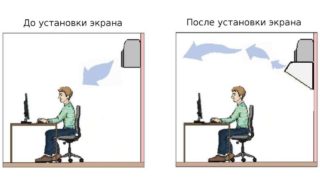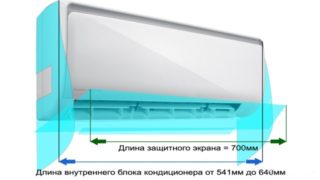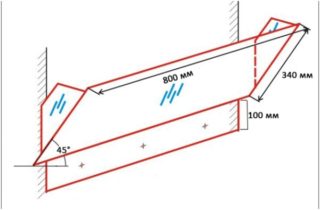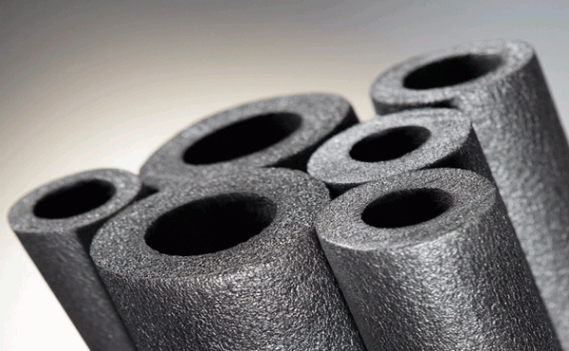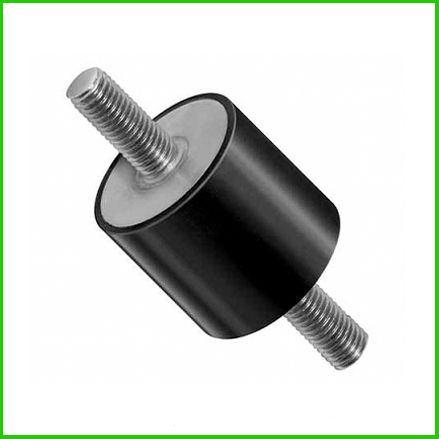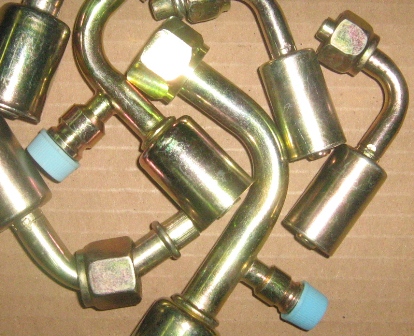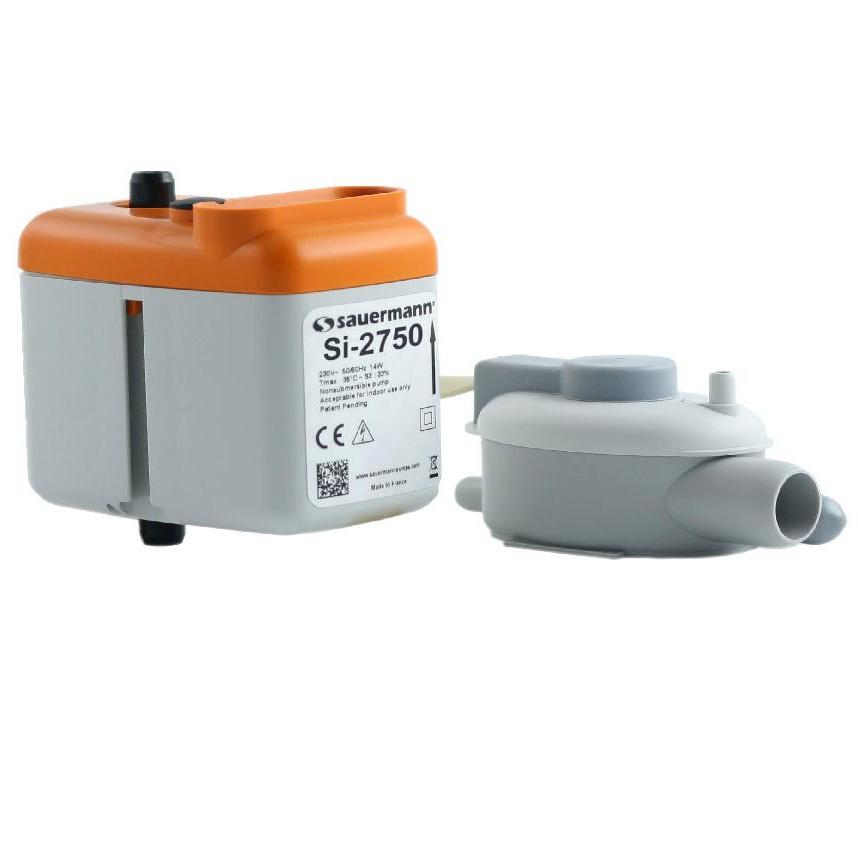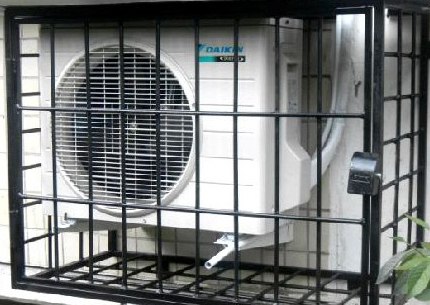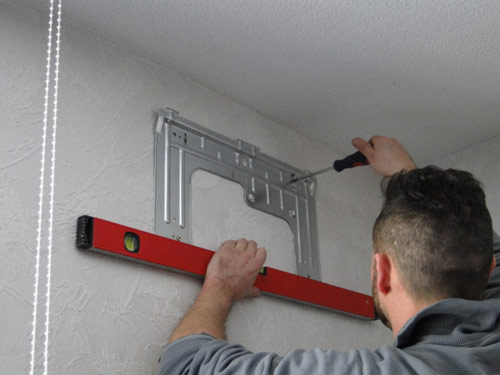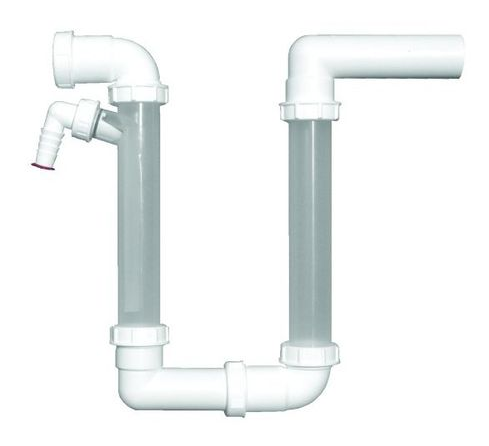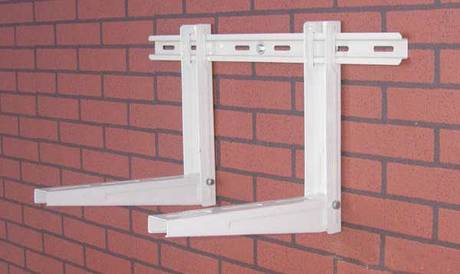A protective screen for an air conditioner is called differently: a diffuser, a deflector, a reflector. The purpose of the device is to redirect the cold stream upward. They came up with it due to the fact that a sharp change in temperatures outside and in a chilled room leads to respiratory diseases. They are especially susceptible to children, whose immunity has not yet been formed, and the elderly, whose immune system can no longer cope with the stress.
On the other hand, a powerful jet creates a kind of draft, which affects the state of the peripheral nervous system and, with prolonged exposure, can lead to pneumonia. The problem is especially urgent in office premises, where employees are forced to stay at their workplace for a long time.
The principle of operation of the reflector screen
A reflector for an air conditioner is a panel made of dense material that is installed along the path of cold masses and redirects them upward - to the ceiling. The panel must be fixed securely to the walls or to the air conditioner itself. Depending on the selected material and its weight, simple screws or dowels are used.
At home, when making a screen from a light material, for example, cardboard, you can get by with double-sided construction tape. Heavier materials should not be attached to tape as they may fall off.
The industry offers several types of devices that differ:
- design;
- configurations, depending on the type of air conditioner (wall, ceiling, cassette);
- materials.
Screens for wall-mounted household split systems are most often found on sale. Based on the width of the indoor unit, a suitable divider is selected and mounted on the wall. In order for the split to work as usual, some rules must be followed during installation.
Types and types of protective screens for the air conditioner
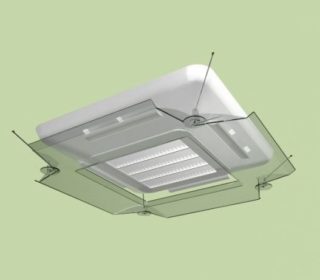
The divider for the air conditioner is distinguished by the type of installation of the equipment:
- For wall system. The device is wall-mounted.
- For ceiling air conditioner. Mounts are located on the ceiling or behind the grille, and the air flows diverge in different directions.
- For centralized cassette equipment.
- Hinged, which is attached to the body of the air conditioner. This type is used for floor monoblocks.
By type of material:
- Plastic. Transparent or opaque material is used. It does not always fit into the interior, but it is easy to do it with your own hands, since the material is easy to bend. Attaching to a wall or ceiling is not a problem.
- Cardboard. The lightest material - bends easily, you can give any shape. Not aesthetically pleasing, but the deflector will perform its functions. You can fix it with tape to the side walls of the air conditioner.
- Plexiglas is a type of plastic.Lightweight material, but requires gentle handling when bent. A building hair dryer is required to warm up.
- Acrylic. It is most often used in the manufacture of protective screens for air conditioners of various types. Can be matched by texture, color, thickness.
- Polycarbonate. Transparent lightweight material, very durable (several hundred times stronger than glass), non-toxic.
- Metal. In the manufacture of screens, thin sheets are used. It is appreciated for its resistance to bending if it is necessary to make a divider structure in which there are side protection wings.
By device design:
- standard;
- rotary - with the possibility of air distribution in the vertical direction;
- with the possibility of direction in any direction horizontally.
The price of the product depends on:
- from the presence of functions for adjusting the air flow;
- from the material from which the device is made;
- from decorative qualities - with glued films, built-in diode lighting.
Some companies manufacture and install protective diffusers specifically for children's rooms with a corresponding design. Individual orders are calculated based on the complexity of the work and installation.
Splitter installation requirements
It is recommended to locate the structure 35 cm from the air conditioner in order to provide free exit and not interfere with the operation of the equipment. To direct the flow upward, the leading edge is folded at a 45 degree angle. The depth of the deflector should be twice that of the indoor unit in order to maximize the safety of people in the room.
How to make a screen to redirect cold air
Of the tools when making at home, the following can be useful:
- screwdriver;
- ruler 1 m long;
- pencil or marker;
- screwdriver, drill for drilling holes;
- self-tapping screws from 3 to 6 pieces;
- scissors or knife;
- building hair dryer for heating plastic, plexiglass or acrylic;
- glass cutter, if the material for the screen is glass;
- building level.
Do-it-yourself plexiglass protective screen - stages of work
Prepare a material that should be the same width as the air conditioner plus 15-20 cm of margin on the sides for organizing the wings. You can use plexiglass, the thickness of which is at least 3 mm, so that there are no vibrations from the outgoing air flow.
- Make a pattern. Mark 15-20 cm on the sides and draw a line under the ruler. These are the future side wings. They do not allow cold air to disperse around the room, therefore they are made high enough.
- On one side, measure 20 cm - this will be the mount. Mark drilling points for self-tapping screws. Saw along the fold lines at the point of the intended wall attachment.
- Bend the plexiglass along the lines, placing it on the edge of the table along the intended fold. Heat with a blow dryer and gently fold the sides down to a 45-degree angle. The place of attachment to the wall is 90 degrees.
- Drill the holes for the self-tapping screws with a drill.
- Before mounting on a wall, it is advisable to know exactly where the electrical wiring runs so as not to damage it. Attach the screen to the wall and mark the places for the screws with a marker. To install strictly horizontally, use a building level. Drill holes in the wall and insert plastic dowels.
- Screw the screen to the wall with a screwdriver.
The ceiling deflector differs in pattern and fastening method. The dimensions of the air conditioner are marked on the pattern. Leave room for folds around the edges. For aesthetics, they should be the same width.Plexiglass is folded with a hair dryer on four sides. There are two ways to fix the device:
- To the ceiling. To do this, use a bracket, one side of which is attached to the screen, the other to the ceiling.
- Staples behind the grill of the air conditioner. In this case, only one side of the bracket is screwed to the plexiglass. The second side is put on the edge of the grill.
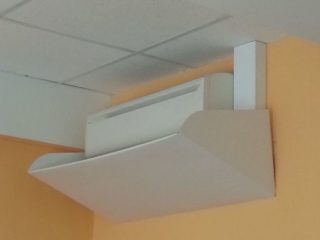
If there is an urgent need to organize a protective screen for a household split system, you can use thick cardboard and tape to attach to the body of the indoor unit. Such a structure does not look very presentable, but in the absence of materials and tools, it saves people from colds in the hot season.
The pattern for the cardboard shield features taller side wings. They should be equal to the height of the indoor unit so that they can be glued to the body with adhesive tape. You need to bend them 90 degrees. For security, the front edge of the shield is also glued to the body to keep the attachment in place for longer.
To give a more aesthetic appearance, the cardboard is painted in a suitable color or a film with a pattern is glued onto it.

